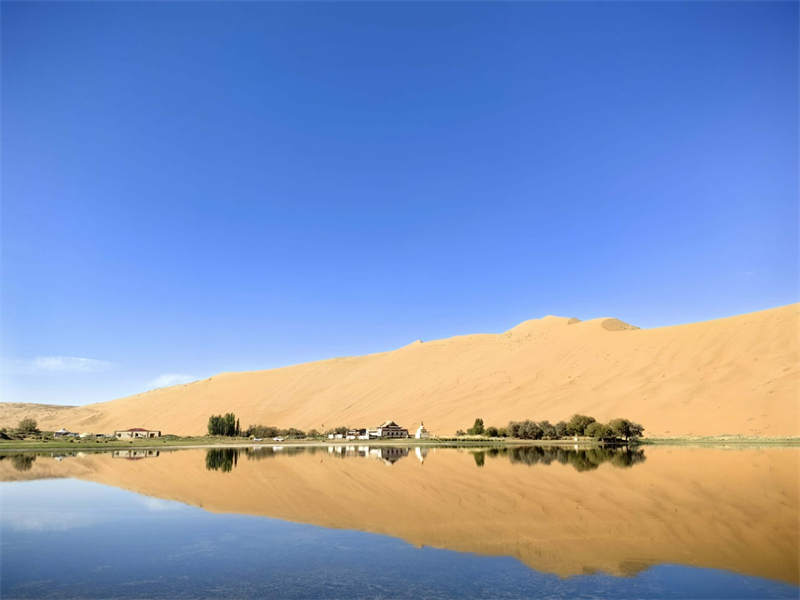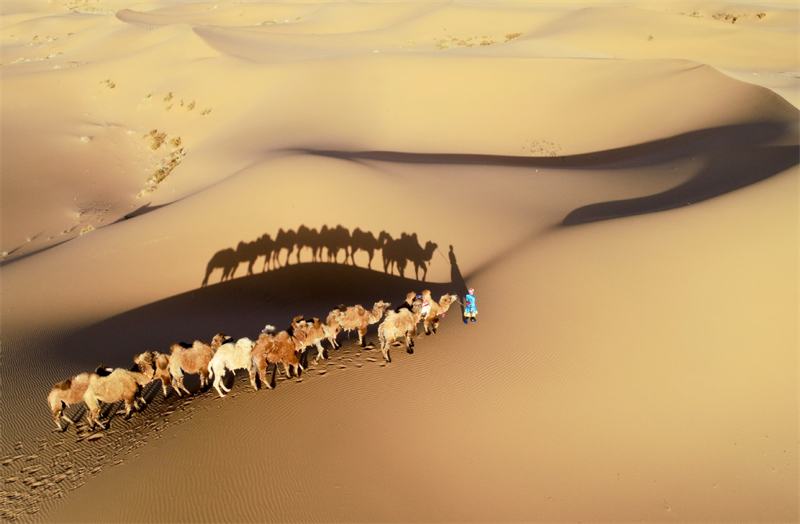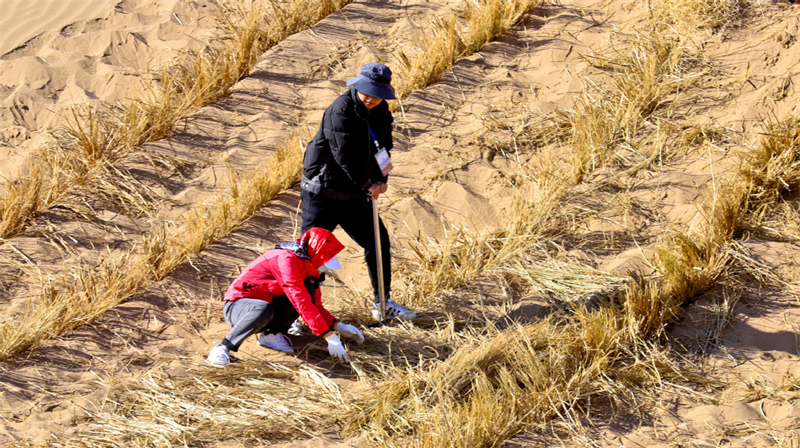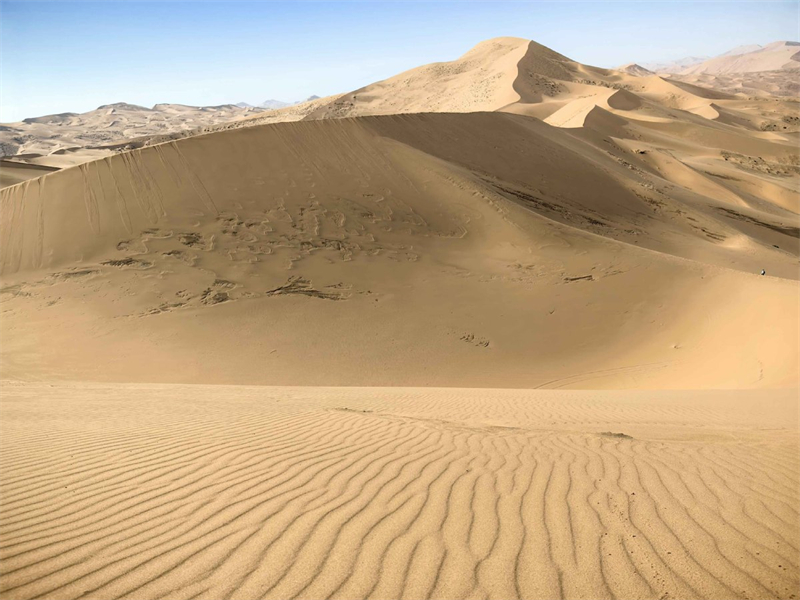Herders live in harmony with desert of 'Five Wonders'
- (China Daily)
- Updated: 2024-10-15

Su Min Jaran Lake in the Badain Jaran Desert, Alshaa Right Banner, Inner Mongolia autonomous region, pictured on Sept 20. ZHANG WEI/CHINA DAILY
Deserts are typically associated with searing heat, dryness and inhospitable landscapes.
However, the Badain Jaran Desert in Alshaa League, Inner Mongolia autonomous region, defies these conventions. In this vast wilderness dotted with sparkling sapphire lakes and towering sand dunes, there is an unbreakable bond between people and the natural environment.
Nestled in the arid expanse of the Alashan Plateau in northwestern China, the desert, a World Heritage site, challenges preconceptions of desolate deserts with its vibrant ecosystem.
Badain Jaran Desert is China's second-largest drifting desert and is renowned for its distinctive high dunes, "singing" sand, clusters of lakes, clear springs and ancient temples — collectively known as the "Five Wonders".
Beyond these attractions, the desert is home to other spectacular attractions such as Daghtu Lake, a pink body of water that owes its unusual color to mineral salts.
Animals, particularly camels, flourish in this unlikely sanctuary and live in harmony with their human handlers.
"Our roots run deep in this land, spanning three generations. Camels are our lifeblood, inseparable from the essence of the Badain Jaran Desert," said Zhang Jun, Party secretary of Bayin Bo Rige village of Badain Jaran town in Alshaa Right Banner.
In 1956, Zhang's grandfather settled here, sustaining himself through herding animals as he traversed the land on foot. By the time Zhang's father was born in 1960, camels were the primary mode of transportation. For Zhang's generation, off-road vehicles are today the norm for traveling through the desert.
The rapid evolution of transportation in Badain Jaran Desert is a great source of pride for Zhang who sees it as a reflection of the nation's progress.
"From our life in the desert, I feel that the country has developed very quickly, which makes me particularly gratified," he said.

A herder walks with his camel caravan in the Badain Jaran Desert. WANG ZHENG/FOR CHINA DAILY
Special connection
The desert holds a special place in the hearts of the herders who inhabit, protect, and raise their animals in it.
"Across generations, we have grazed, survived, nurtured our kin, earned our livelihoods, upheld our heritage, and treasured these desert plains as our communal playgrounds," said Zhang. "This desert is not just our dwelling place, but our legacy. We must care for our land, leveraging the expertise of various departments to safeguard our resources for future generations."
Alatenggerile, a veteran herder from Badain Jaran Village in Yabulai town, epitomizes the enduring bond between the desert and its inhabitants. "Nearly every lakeside in the desert hosts herders like us, sustaining our livelihoods through the diligent care of camels and sheep," he said.
"As I grow older, I increasingly believe that my home is the best place," Alatenggerile added.
On July 26, following seven years of effort, Badain Jaran Desert: Towers of Sand and Lakes was finally admitted to the World Heritage List at the 46th session of the UNESCO World Heritage Committee held in New Delhi, India.
The desert has multiple tall dunes, including the Bilutu Peak, the world's highest such peak with an altitude of more than 1,611 meters and a relative height of over 500 meters, according to a People's Daily report.
The tall dunes are what create the desert's "singing sands", producing a mysterious booming sound when the wind blows. The Baoritaolegai area with steep peaks and sand dunes of varying heights on the edge of the desert is dubbed the "Kingdom of Singing Sands "because of its spectacular sounds.
There are 144 crystal-clear lakes nestled between dunes, supporting lush vegetation and diverse wildlife while creating unique desert landscapes, the report said. Natural springs in the desert are famous for their purity. The most famous spring water of the desert comes from the Yinderitu Lake, which has 108 springs.
Of the desert's temples, the Badain Jaran Buddhist temple built in 1755 is a major landmark and is often referred to as the "Forbidden City of the desert".

Volunteers from Gansu province help lay sand-barriers in the Badain Jaran Desert in October. WANG JIANG/FOR CHINA DAILY
Benefits of listing
The UNESCO designation sets the stage for further exploration of the formation of the desert megadunes and the preservation of its interdunal lakes. Notably, the interests and needs of local inhabitants were fully considered during the application process for UNESCO listing. The herders' authentic lifestyle is seen as an indispensable component of the interconnected desert ecosystem, with locals actively involved in conservation efforts.
Preserving natural heritage sites involves not only maintaining the integrity of the natural surroundings, but also securing their legacy and sustainable use.
In 2023, from June 5 to 11, Professor Kyung Sik Woo from the International Union for Conservation of Nature conducted on-site assessments in the Badain Jaran Desert. During the evaluation, he observed the herdsmen, who have long resided in the region, tending to sheep and camels as part of their daily routine.
"Pastoralists' grazing practices may enhance the natural landscape, attracting more tourists," the professor said.
"In reality, pastoralists have already become part of nature, meaning there won't be further restrictions on their way of life. They have seamlessly integrated with nature, and both pastoralists and the environment are entities we all need to protect," he added.
Alatenggerile's family has lived for generations in Badain Jaran Desert, sustaining themselves through herding and grazing animals.
"During the World Heritage application process, each village organized meetings with the herders, listened to our opinions, and addressed our concerns. Once we received assurances that we could continue to live here and develop tourism, we all felt relieved and happy," Alatenggerile said.
"The application marks a positive step forward. The influx of tourists brings economic opportunities. Now that the application has succeeded we can expect a steady flow of visitors, propelling Badain Jaran toward a brighter future," he added with a smile.

Tourists walk through the desert. WANG ZHENG/FOR CHINA DAILY
Visitors welcome
The inhabitants of Alshaa Right Banner have long relied on nomadic herding, and have cultivated a distinctive culture in the desert.
Virtually every haizi (lake) nestled in the Badain Jaran Desert serves as a home for herders who tend to camels and sheep, creating a picturesque tableau against the desert backdrop.
In recent years, with improved transportation, more tourists have explored the desert, prompting some of the herders to enter the tourism industry.
"Since 2005, 13 households have offered homestays. Improved transport accessibility has made it easier for vehicles to reach us, enhancing travel convenience," Alatenggerile said.
"Significant changes have occurred in our living conditions. Life has improved since 2010, and the herders managing homestays are thriving, enjoying increased earnings."
Alatenggerile said when he was young a camel journey could take up to 15 days. "Nowadays, transportation is more convenient," he said.
During the busy tourist season, Alatenggerile works as a guide, which boosts his annual income by 50,000 to 60,000 yuan ($7,125 to $8,550). "This summer has seen a surge in tourist numbers, surpassing the figures of the last two years," he said.
Party official Zhang added: "The successful World Heritage application is a boon for our hometown. The increasing number of tourists has not only enhanced our quality of life but also brought about positive transformations."
Alatenggerile's living conditions continue to improve. His 15-year-old son is enrolled in school in Alshaa Right Banner, where the family has a home.
Zhang said: "We are content. It is crucial to safeguard the desert's resources. Through hard work, I am confident that we can achieve greater prosperity. This land is full of treasures."
He added that safety is a priority in the desert. "We also urge all travelers to prioritize safety, tailoring their activities to their physical abilities and health conditions."

Bilutu Peak in the Badain Jaran Desert, Alshaa Right Banner, Inner Mongolia autonomous region seen on Sept 21. ZHANG WEI/CHINA DAILY
Conservation efforts
The local government prioritizes attracting tourists while at the same time protecting the ecological ethos that underpins tourism development. This approach has been a success, with environmental awareness among tourists gradually increasing over the years.
"The current state of ecological preservation is commendable. Litter is now a rarity," said Alatenggerile. "All waste is meticulously collected and processed in the town. There is a resolute commitment to environmental stewardship."
Zhang said: "We have been sustained by the desert's groundwater springs since childhood. The town also relies on this water source. The sanctity of the desert environment must be upheld at all costs."
Over the years, China has actively implemented the Three-North Shelterbelt Project to combat desertification. As a crucial location in the region, Alshaa Right Banner has been strongly engaged in efforts to prevent the merging of the Badain Jaran and Tengger deserts.
The World Heritage Committee concluded the commitment to controlling desertification in the Badain Jaran Desert showcased the deep concern locals have for their land, which contributes significantly to the conservation of the site.
The desertification control measures in the Badain Jaran Desert have bolstered its appeal and played a key role in its successful World Heritage designation.
"The most important safeguard for the Badain Jaran Desert is conservation, maintaining its original state," said Dong Zhibao, vice president of Shaanxi Normal University.
He said there is symbiotic relationship between heritage conservation and desertification control.
"The crux of sand control and desertification prevention in the Badain Jaran Desert lies in halting the ongoing expansion of the desert, safeguarding human habitats, and honoring the desert as a vital component of Earth's natural ecosystem.
"By preserving the desert's original state, we can foster a harmonious coexistence between humanity and nature," he said.


